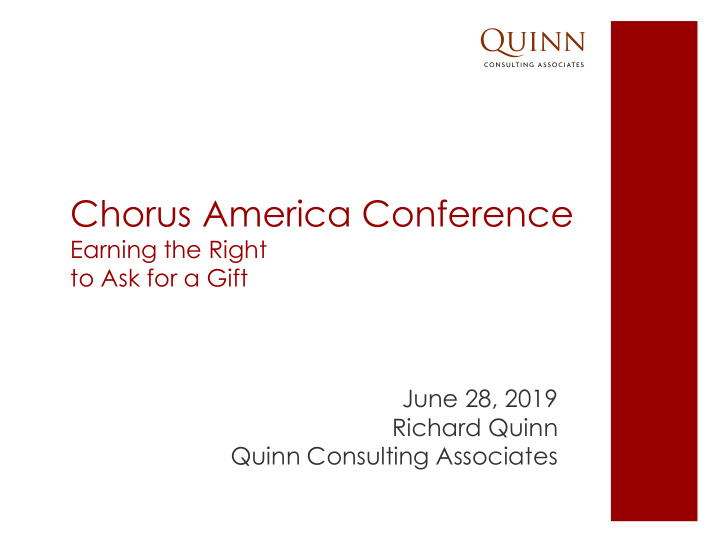



Chorus America Conference Earning the Right to Ask for a Gift June 28, 2019 Richard Quinn Quinn Consulting Associates
What’s the #1 reason individuals make gifts to non-profit organizations?
The answer…
Because… they were asked.
However…
…that’s not the whole story.
“People give to people more than they give to great missions.”
Let’s modify this…
People give through people they trust to organizations they trust.
But even then…
We must… earn the right to ask for a gift.
How precisely do we earn the right?
“Ask someone for advice, and you get money. Ask someone for money, and you get …”
ADVICE!
The right order is critical.
Let’s disrupt, shall we?
The solicitation cycle
A newer approach
Solicitation Cycle Commitment Curve Identify Awareness Cultivate Interest Solicit Engagement Steward Commitment
The Solicitation Cycle reflects what the organization wants. The Commitment Curve reflects what the donor wants.
The most effective form of engagement focuses on the donor.
Step 1: Build your donor’s awareness
Send regular updates Impact stories Press pieces Testimonials
Step 2: Discover your donor’s unique interests
Ask them… What interests you most about what we do?
Step 3: Deepen your donor’s engagement
Ask them… Why is that particular part of our mission so important to you?
Step 4: Cultivate your donor’s commitment
Invite them… …to see their particular interest in action …to see you meet the needs they care about
Exercise Five Names
The Advice Meeting
Advice about what?
Reputation
Impact
Leadership
Donor Engagement
Success of your events
Vision for the future
An advice meeting is…
A “purposeful” conversation
What’s the first step?
Send letter or email.
Pick up the phone.
If you see a donor out and about...
What is the message?
Simply this…
Your engagement as a donor is a priority.
We are committed to doing great work in our community.
As a donor, your opinions and advice matter to us.
And I would like to share our story with you…
…and hear your thoughts about it.
If your donor says…
Are you asking me to make a donation?
You say, No.
At this point, all I would like is to get your feedback on our plans for the future.
So what do you say? Have time for coffee?
The Arc
Phase 1: Settle
Any vacation plans? How are the kids? How about those Phillies?
Phase 2: Confirm
You said you had about 30 minutes for our conversation today. Is that still the case?
Phase 3: Explore
“Thanks for agreeing to meet. Tell me…what do you think should be our #1 priority right now?”
“I appreciate your taking the time to speak with me about our event. The floor is yours. I would love to hear your thoughts.”
“Thank you so much for attending our most recent performance. It was a bit of a departure for us. What did you think?
Phase 4: Present
“Would you be willing to have an additional conversation with our Executive Director?” “Would you be interested in serving on a committee?” “Would you be interested in hosting an event for us?”
Then… …be absolutely quiet. Shhh…
Phase 5: Explore
Listen. Discuss the request in more detail. Answer questions. Overcome objections.
Phase 6: Confirm
“How about I circle back with you in a week or two?”
Let’s pause for a moment.
The Advice Meeting Settle Confirm Explore Present Explore Confirm
Overcoming Objections
….when getting the meeting
“Why did you come to me for this?”
“I’m crazy busy. Just email me something.”
…at the meeting
“I really don’t have any extra time in my calendar for this.”
“I have to think it over.”
“Leave your materials with me.”
“I need to think about it.”
“I have to discuss this with my partner.”
“No. I’m not interested.”
May I ask you…
Is it the project?
Is it the timing?
Is it the leadership?
Is it the organization?
Let’s reflect…
Advice meetings are critical to donor engagement.
You’ve respected their journey, not imposed yours.
When you have engaged the donor on their terms….
…they are far more likely to find joy in their philanthropy.
Recommend
More recommend